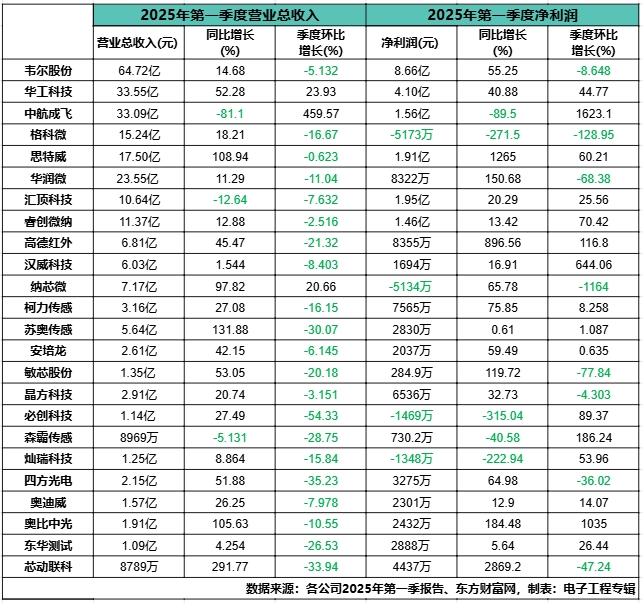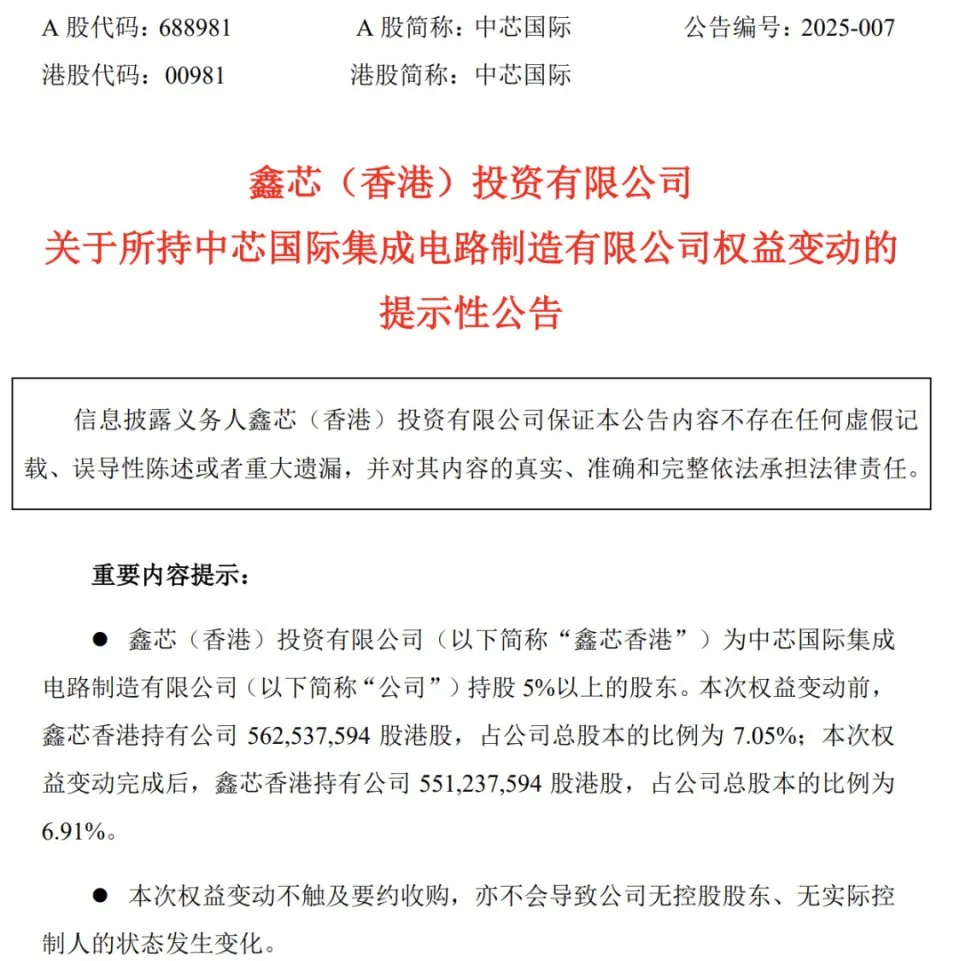
Benefiting from the “national subsidy” policy implemented since the beginning of 2025, the Chinese consumer electronics market in the first quarter of this year is significantly better than the global market. According to Canalys, the global smartphone market grew by 1% year-on-year in Q1 2025. The Chinese smartphone market performed relatively strongly, with shipments increasing by 5% year-on-year, reaching 70.9 million units. In addition to smartphones and tablets, the subsidy policy has also extended to the home appliance sector, effectively promoting the recovery of the home appliance market, especially in the mid-to-high-end product areas, driving consumption upgrades and product iterations.
Continuing the development trend of 2024, the Chinese sensor industry maintained slight growth in Q1 2025, a trend that naturally benefits from policy support and consumption recovery. However, overall, mature sensor technologies still dominate, and most sub-segment sensor markets show little growth, prompting some sensor companies to actively explore emerging technologies and applications in hopes of creating new growth curves. Meanwhile, domestic companies still lag behind international giants in terms of technology level and market share, with high-end products largely dependent on imports.
Revenue continues to improve, but company profits are thin.
This article compiles and organizes the Q1 2025 financial report data of 24 listed Chinese sensor companies. From the company data, it can be seen that following the industry recovery trend of 2024, the operational performance of Chinese sensor companies continued to improve in Q1 2025.
Chart 1:Operational Status of Chinese Sensor Companies in Q1 2025 (Incomplete Statistics)

In terms of company revenue, except for Goodix Technology, AVIC Chengfei, and Senba Sensors, the vast majority of sensor companies achieved positive growth. Among them, Sitaro (108.94%), Suoao Sensors (131.88%), Orbbec (105.63%), and Chipone (291.77%) all achieved over 100% growth. However, in terms of quarter-on-quarter growth, except for Huagong Technology and Naxin Micro, the other 21 sensor companies experienced a decline, mainly due to the traditional off-season during the Spring Festival. In terms of net profit, it generally grew in line with company revenue, with the exception of Geke Micro, Bichuang Technology, Senba Sensors, and Canrui Technology, where other companies achieved year-on-year growth.
Meanwhile, from the 24 listed Chinese sensor companies surveyed, it can be seen that the companies in the Chinese sensor industry are generally small in scale, with less than half of the companies achieving revenue over 500 million yuan, and only about 1/5 of the companies achieving net profits over 100 million yuan. This also reflects the objective situation of the industry: the Chinese sensor industry is dominated by small and medium-sized enterprises, with serious product homogeneity and a competitive landscape that is “small and scattered.” At the same time, the domestic sensor industry shows a fragmented characteristic, with limited market space in each sub-segment, leading to frequent vicious competition and thin profits for companies.
The strong continue to strengthen, occupying competitive advantages.
Overall, the competition in the Chinese sensor industry is fierce, mainly influenced by technology, brand, and industrial chain collaboration. From the perspective of individual companies, some large enterprises leverage their strong R&D capabilities and brand influence to gain advantages in market competition.
1. Weir Shares
Weir Shares continued its high growth trend, achieving revenue of 6.472 billion yuan in Q1, a year-on-year increase of 14.68%, setting a record high for Q1 revenue; net profit reached 866 million yuan, a year-on-year increase of 55.25%. This growth is attributed to the company’s image sensor products penetrating the high-end smartphone market and automotive autonomous driving applications, especially the OV50H image sensor gradually replacing similar products from overseas competitors. Benefiting from automotive intelligence, Weir Shares’ automotive CIS revenue has grown rapidly, becoming a new growth point for the company, with 2024 revenue reaching 5.905 billion yuan, an increase of 29.85% compared to the previous year. Of course, the consumer electronics “national subsidy policy” in Q1 this year has also greatly benefited Weir Shares’ image sensors.
2. Huagong Technology
Huagong Technology’s main business performed well in Q1 2025, with both revenue and net profit growing year-on-year. The company’s total operating revenue was 3.355 billion yuan, a year-on-year increase of 52.28%, and net profit attributable to the parent company was 410 million yuan, a year-on-year increase of 40.88%. This growth is driven by the rapid increase in demand for PTC heating components and sensors from new energy vehicle manufacturers as the penetration rate of the new energy vehicle market rises quickly.
3. AVIC Chengfei
AVIC Chengfei, formerly known as AVIC Electric Measurement, was once a leader in domestic strain sensors, with products widely used in aviation measurement, intelligent transportation, and other fields, characterized by high technical barriers, but the market size of the sub-segment is limited. In 2023, AVIC Electric Measurement initiated the acquisition of Chengfei Group and completed the asset restructuring in 2024, officially transforming into an aircraft equipment manufacturing enterprise. This asset restructuring has significantly changed the business structure of AVIC Electric Measurement, with its asset scale rising sharply, transforming from a leading strain sensor company to a “J-20 manufacturer,” with the proportion of military aviation revenue rising to 62%, while the sensor business has retreated to second place, accounting for only 23%. In February of this year, the stock abbreviation of “AVIC Electric Measurement” was changed to “AVIC Chengfei.” The company’s Q1 operating revenue was 3.309 billion yuan, a decrease of 81.10% compared to the same period last year, mainly due to the impact of product production cycles, resulting in a year-on-year decrease in sales. The net profit was 156 million yuan, a decrease of 89.50% compared to the same period last year. The significant decline in net profit is directly related to the decrease in operating revenue. However, due to the integration of Chengfei Group’s assets, AVIC Chengfei is expected to benefit from national defense modernization and aviation equipment upgrades in the future.
4. China Resources Microelectronics
China Resources Microelectronics has strong manufacturing capabilities in power semiconductors and smart sensors. In the smart sensor field, the company’s products include MEMS pressure sensors, smoke sensors, and optoelectronic sensors. Pressure sensors, as the largest sub-segment in the MEMS sensor industry, are widely used in the automotive sector, but this market is mainly occupied by large foreign semiconductor companies such as Bosch and Infineon, providing China Resources with ample replacement space. The company’s Q1 operating revenue was 2.355 billion yuan, a year-on-year increase of 11.29%; net profit attributable to the parent company was 83.216 million yuan, a year-on-year increase of 150.68%.
5. Geke Micro
As a major domestic image sensor manufacturer, Geke Micro turned from profit to loss in Q1 2025, experiencing negative profits. Although the company’s operating revenue still maintained double-digit growth, increasing by 18.21% year-on-year, its net profit turned from profit to loss, amounting to -51.731 million yuan, a year-on-year decrease of -271.5%. This is mainly related to the continuous decline in the company’s sales gross margin, which was 30.48%, 29.57%, and 22.82% in 2022, 2023, and 2024, respectively, showing a continuous downward trend. The main reason for this phenomenon is that Geke Micro’s high-end transformation is still in its early stages, and the second growth curve developed in the automotive chip, AR/VR, and other fields has not yet reflected in the company’s revenue and net profit. In the future, Geke Micro’s operational performance, especially in terms of net profit, will depend on the market penetration of several 50-megapixel image sensors and the new driving force brought by the company’s “second growth curve.”
6.. Sitaro
Sitaro’s operating revenue reached 1.75 billion yuan in Q1 2025, a year-on-year increase of 108.94%; net profit was 191 million yuan, a year-on-year increase of 1264.97%. This remarkable performance is related to the company’s explosive growth in three major fields: smartphones, security, and automotive electronics. Among them, the company deepened cooperation with multiple clients in the smartphone sector, with significant increases in shipments of several high-end 50-megapixel products for flagship smartphones, wide-angle, telephoto, and front-facing lenses, as well as high-cost-performance products for regular smartphones. Shipments of products used in smart driving (including surround view, side view, and front view) and cabin applications also saw significant year-on-year increases; products in the smart security field continued to iterate, performing excellently in the market.
7.. Goodix Technology
Goodix Technology, a major domestic fingerprint recognition and touch chip manufacturer, showed a trend of net profit growth but a decline in operating revenue in Q1 2025. The company’s revenue was 1.064 billion yuan, with a net profit of 195 million yuan, maintaining a gross margin of 43.34%. The increase in net profit is mainly due to the increase in investment income from the sale of DCT. At the same time, the company’s performance mainly relies on R&D-driven growth, which has improved its profitability in Q1 2025, with a gross margin of 43.34%, an increase of 7.34 percentage points year-on-year. This indicates that Goodix Technology has strong capabilities in cost control, enhancing product added value, and converting R&D investment results. However, the decline in company revenue raises concerns, as fluctuations in end customer demand may affect long-term stability.
8.. Ruichuang Micro Nano
Ruichuang Micro’s core business is infrared thermal imaging, accounting for over 90%, and it is one of the few domestic companies capable of independently developing and mass-producing infrared detector chips, with products widely used in industrial temperature measurement, security monitoring, automotive assistance, and outdoor consumer applications. Due to the rapid development of low-altitude economy, industrial temperature measurement, and automotive assistance, the market demand for the company’s infrared thermal imaging products is strong. In Q1 2025, it achieved total operating revenue of 1.137 billion yuan, a year-on-year increase of 12.88%; net profit attributable to the parent company was 146 million yuan, a year-on-year increase of 13.42%.
Other listed sensor companies are not elaborated on in detail, but some companies have strong competitive strength in their respective sub-segments. For example, Hanwei Technology, Sifang Optoelectronics, Keli Sensors, and Senba Sensors continue to enhance product competitiveness in their sub-segments, accelerating their pursuit of international advanced enterprises, with broad development space in the future. From the perspective of company scale and operational performance, these companies are still constrained by the monopolistic competitive advantages of foreign enterprises and the limitations of market growth in related sub-segments, and they need to increase technological innovation and product iteration to gradually narrow the gap with international advanced levels.
Mature market growth is slow, seeking a “second growth curve”.
In recent years, the overall Chinese sensor market has maintained growth, but the growth rate of mature markets has slowed down, especially for some mid-to-low-end sensor products, which not only face fierce competition, forming a “price red sea,” but also encounter international competitive pressure. In particular, domestic companies still have significant shortcomings in perception information, intelligence, and networking technologies, further limiting the expansion of mature markets and causing high-end products to rely on imports.
Meanwhile, the rapid development of emerging application fields is becoming an important growth point for the sensor industry. The Internet of Things, artificial intelligence, and 5G technology are emerging technologies that provide broad space for sensor applications. In 2025, the application of sensors is gradually expanding in fields such as medical care, agriculture, environmental monitoring, autonomous vehicles, augmented reality (AR), and virtual reality (VR). In particular, emerging sensor types such as wireless sensors, microsystem sensors, and biosensors are considered the main sources of future market growth.
IDTechEx predicts that by 2033, the annual demand for automotive sensors (including cameras, radar, and lidar) will grow more than sixfold. With the widespread application of wearable technology in health monitoring, next-generation human-machine interfaces, industrial IoT, and extended reality, the global wearable sensor market is expected to reach $7.2 billion by 2035. Global Market Insights also predicts that by 2026, the global robotics sensor market will exceed $4 billion.
Currently, Chinese sensor companies are increasingly focusing on emerging technologies and applications to seek new growth points. Among them, Weir Shares is actively expanding into the automotive electronics market, with its automotive CIS already applied in well-known car manufacturers such as BMW, Mercedes-Benz, Audi, and Tesla, and certified with NVIDIA’s Orin platform. It is expected that by 2025, its automotive CIS market share will exceed 40%. Sitaro is actively exploring emerging blue ocean markets such as AR/VR, medical imaging, and facial biometrics. The company has developed high-performance image sensors suitable for AR/VR devices and maintains close cooperation with several leading clients. Naxin Micro, after suffering losses in the price war with international giants, has begun to bet on humanoid robots to create a “second growth curve.”
In the future, Chinese sensor companies still need to increase R&D investment, especially in high-end sensor fields such as MEMS sensors and inertial sensors, to improve product performance and added value, reducing dependence on imports. At the same time, smaller companies should focus on niche markets, becoming “invisible champions” in the industry through specialized development, forming differentiated competitive advantages. Additionally, by integrating emerging technologies such as the Internet of Things and artificial intelligence, they should promote the intelligent and digital transformation of the sensor industry, while enhancing product performance and actively exploring more application scenarios.
Hot Articles
2025 China Fabless 100 Listed Company Rankings
2025-05-12

Toyota Plans to Acquire Nezha Automobile!
2025-05-12

The Big Fund Reduces Holdings in SMIC and Huahong Company
2025-05-10

100 kilometers away, killing the “Gust” – Where does the J-10C win?
2025-05-09

Xiaopeng Flying Cars Go on Sale, 2.07 Million Yuan Each
2025-05-07

